Bacterial pathogens share genes

Disease symptoms of Pseudomonas syringae on kiwi vine leaves observed in the field
(c) Dr. Honour McCann / Max Planck Institute, Germany
…to outsmart treatments and adapt to new environments.
A new study published in PNAS sheds light on how bacterial plant pathogens, like Pseudomonas syringae, rapidly evolve resistance to antibiotics and adapt to changing environments. This is particularly concerning as copper-based antimicrobials are commonly used in agriculture to control these very pathogens. The study reveals a previously unknown mechanism by which these bacteria gain new abilities due to mobile genetic elements called Integrative and Conjugative Elements (ICEs). Researchers identified a new family of ICEs that carry extra genetic material that allow pathogens to spreading genes for copper resistance and virulence across even distantly related P. syringae strains.
A destructive outbreak of kiwifruit bleeding canker disease threatened the global fruit industry and fragile local economies from 2010 onwards. The outbreak continues to affect kiwifruit-growing regions in Europe, Asia, Australia and Chile. This pandemic was caused by the bacterial pathogen Pseudomonas syringae, a common culprit among many agricultural plant diseases.
P. syringae can live on the plant surface as an epiphyte. To cause disease, it enters the plant via wounds or natural openings such as stomata. The pathogen parasitizes the water and nutrients inside the plant tissue, multiplying quickly and eventually causing host death. Despite the many defence mechanisms plants have evolved to reduce pathogen entry of pathogens, recent disease outbreaks in agricultural crops have been particularly destructive, posing effective control challenges. The advent of a new, aggressive strain known as Psa is one such example.
Unexpected cargo genes hitchhike into bacteria via mobile genetic elements
Integrative and conjugative elements (ICE) can rapidly introduce new functions to bacteria. They can move from one bacterial cell to another in minutes. The pool of ICEs identified in P. syringae consists of at least 53 distinct ICEs. Each ICE carries a set of core genes responsible for ICE movement and different sets of accessory cargo genes with encoding functions that can alter the bacterium’s ability to survive and grow in different environments. In human pathogens, the cargo genes often encode resistance to antibiotics frequently used in hospitals. Similar to ICEs found in human pathogens, ICEs in P. syringae have antimicrobial resistance genes and cargo genes whose function is not immediately apparent.
“We were already aware that ICEs move rapidly between strains and that different ICEs were circulating among the pandemic pathogen Psa” explains Dr. Honour McCann, Research Group Leader on Plant Pathogen Evolution at Max Planck Institute for Biology in Tübingen. “What surprised us is that a particular set of cargo genes linked to metabolism appears to have recently invaded ICEs, taking advantage of their mobility to spread across Psa and many other destructive P. syringae. This unexpected finding suggests this region might contribute to P. syringae’s ability to grow in different hosts and environments.”
Decoding the mechanisms of how mobile elements reprogram bacterial metabolism
To understand what this new cargo – called Tn6212 – is doing, Dr. Elena Colombi, now at the University of Melbourne, and a team of researchers used sequence analysis, genetics, and measurement of gene expression changes to investigate how Tn6212 affects bacterial growth. Dr. Colombi created multiple gene knockouts (deletions) in Tn6212 and found some were crucial for bacterial growth under nutrient-limited conditions. Strikingly, the absence of the cargo genes impaired the bacteria’s ability to grow well on compounds abundant in plant tissue. The team then found the Tn6212 cargo genes have major impacts on bacterial gene expression, likely reprogramming bacterial metabolism to capitalize on the presence of specific nutrients, resulting in faster growth. Tn6212’s ability to manipulate metabolism helps the pathogen to quickly use its favourite energy sources in a given environment, such as plant tissue. This speed might allow harmful pathogens like Psa to thrive and spread more effectively.
Future research directions will delve deeper into the link between the ICE cargo genes’ manipulation of bacterial metabolism, how this manipulation impacts the success of bacterial pathogens during plant infections, and the spread of mobile elements within bacterial populations. Understanding the dynamics of mobile genetic element movement and cargo gene carriage provides crucial insight into how bacterial pathogens evolve and contributes to the development of targeted control strategies. Understanding how quickly pathogens adapt and interact with plants is essential for developing sustainable agricultural practices, crop resilience, and safeguarding our food supply.
Wissenschaftliche Ansprechpartner:
Dr. Honour McCann
Max Planck Institute for Biology
Max-Planck-Ring 5
72076 Tübingen
Germany
honour.mccann@tuebingen.mpg.de
Originalpublikation:
Colombi, D., et al. Rapid dissemination of host metabolism manipulating genes via integrative and conjugative elements. Proceedings of the National Academy of Sciences, 121(11). https://doi.org/10.1073/pnas.2309263121
Weitere Informationen:
https://www.bio.mpg.de/326032/host-metabolism-manipulating-genes-via-ices?c=5721…
https://www.bio.mpg.de/48883/plant-pathogen-evolution-honour-mccann
Media Contact
All latest news from the category: Agricultural and Forestry Science
Newest articles
Faster, more energy-efficient way to manufacture an industrially important chemical
Zirconium combined with silicon nitride enhances the conversion of propane — present in natural gas — needed to create in-demand plastic, polypropylene. Polypropylene is a common type of plastic found…

Energy planning in Ghana as a role model for the world
Improving the resilience of energy systems in the Global South. What criteria should we use to better plan for resilient energy systems? How do socio-economic, technical and climate change related…

Artificial blood vessels could improve heart bypass outcomes
Artificial blood vessels could improve heart bypass outcomes. 3D-printed blood vessels, which closely mimic the properties of human veins, could transform the treatment of cardiovascular diseases. Strong, flexible, gel-like tubes…





















